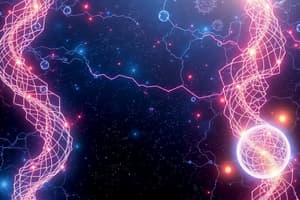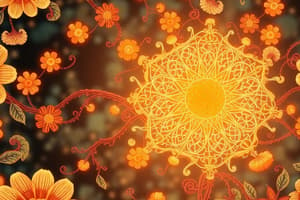Podcast
Questions and Answers
What type of glycosidic bonds are found in the linear chains of glycogen?
What type of glycosidic bonds are found in the linear chains of glycogen?
- α-(1,6) linkages
- α-(1,4) linkages (correct)
- β-(1,6) linkages
- β-(1,4) linkages
Which of the following statements best describes the role of muscle glycogen?
Which of the following statements best describes the role of muscle glycogen?
- It regulates blood glucose levels for the entire body.
- It is primarily used to meet the energy needs of other tissues.
- It is a long-term storage to maintain glucose levels in the bloodstream.
- It serves as a quick, local resource of glucose for the muscle itself. (correct)
What is the immediate precursor molecule that is used to integrate glucose into glycogen during glycogenesis?
What is the immediate precursor molecule that is used to integrate glucose into glycogen during glycogenesis?
- Glucose 1-phosphate
- Ribose 5-phosphate
- UDP-glucose (correct)
- Glucose 6-phosphate
What molecule is released when glycogen is broken down?
What molecule is released when glycogen is broken down?
Besides glycogen, what are the other products obtained from glucose 6-phosphate in carbohydrate metabolism?
Besides glycogen, what are the other products obtained from glucose 6-phosphate in carbohydrate metabolism?
What is the main function of the oxidative reactions in the pentose phosphate pathway?
What is the main function of the oxidative reactions in the pentose phosphate pathway?
What is a primary function of non-oxidative reactions within the pentose phosphate pathway?
What is a primary function of non-oxidative reactions within the pentose phosphate pathway?
Which of the following can be derived from ribulose 5-phosphate?
Which of the following can be derived from ribulose 5-phosphate?
How many ATP molecules are generated from one molecule of NADH that enters the electron transport chain?
How many ATP molecules are generated from one molecule of NADH that enters the electron transport chain?
What is the primary role of the malate-aspartate shuttle in cellular respiration?
What is the primary role of the malate-aspartate shuttle in cellular respiration?
How many ATP molecules are produced by 1 mol of glucose under oxidative conditions, using the glycerol 3-phosphate shuttle?
How many ATP molecules are produced by 1 mol of glucose under oxidative conditions, using the glycerol 3-phosphate shuttle?
Which metabolic pathway directly converts glucose into pyruvate?
Which metabolic pathway directly converts glucose into pyruvate?
Which of the following represents the primary means by which the body stores glucose for rapid mobilization?
Which of the following represents the primary means by which the body stores glucose for rapid mobilization?
Which enzyme is a part of gluconeogenesis, and is used to convert pyruvate to phosphoenolpyruvate (PEP)?
Which enzyme is a part of gluconeogenesis, and is used to convert pyruvate to phosphoenolpyruvate (PEP)?
In the electron transport chain, FADH2 enters at which complex, contributing to ATP synthesis?
In the electron transport chain, FADH2 enters at which complex, contributing to ATP synthesis?
How many ATP molecules are generated directly during the citric acid cycle for each molecule of glucose?
How many ATP molecules are generated directly during the citric acid cycle for each molecule of glucose?
Which of the following is a primary source of blood glucose when dietary intake is insufficient?
Which of the following is a primary source of blood glucose when dietary intake is insufficient?
What is the end product of the pentose phosphate pathway, which is critical for nucleotide synthesis?
What is the end product of the pentose phosphate pathway, which is critical for nucleotide synthesis?
What is the primary function of bioenergetics?
What is the primary function of bioenergetics?
A metabolic reaction with a negative ΔG is described as:
A metabolic reaction with a negative ΔG is described as:
Which molecule is considered the primary energy currency of the cell?
Which molecule is considered the primary energy currency of the cell?
What is substrate-level phosphorylation?
What is substrate-level phosphorylation?
Which of these metabolic pathways is primarily involved in the synthesis of glucose from non-carbohydrate precursors?
Which of these metabolic pathways is primarily involved in the synthesis of glucose from non-carbohydrate precursors?
During glycolysis, what are the primary products besides pyruvate?
During glycolysis, what are the primary products besides pyruvate?
What is the role of NADH and FADH2 in the electron transport chain?
What is the role of NADH and FADH2 in the electron transport chain?
Where does the citric acid cycle take place in the cell?
Where does the citric acid cycle take place in the cell?
Fermentation is a process used to regenerate what molecule in the absence of oxygen during glycolysis?
Fermentation is a process used to regenerate what molecule in the absence of oxygen during glycolysis?
What is the primary role of the electron transport chain?
What is the primary role of the electron transport chain?
Which process links glycolysis to the TCA cycle?
Which process links glycolysis to the TCA cycle?
Which of the following is a direct product of the pentose phosphate pathway?
Which of the following is a direct product of the pentose phosphate pathway?
What is the role of oxygen in the electron transport chain?
What is the role of oxygen in the electron transport chain?
What is the purpose of hydrogen ions being pumped to the outer membrane of the mitochondria during electron transport?
What is the purpose of hydrogen ions being pumped to the outer membrane of the mitochondria during electron transport?
What is the overall net production of ATP in glycolysis?
What is the overall net production of ATP in glycolysis?
Flashcards
Oxidative Phosphorylation
Oxidative Phosphorylation
The process of generating ATP using the energy released from the movement of protons across a membrane.
Electron Transport Chain (ETC)
Electron Transport Chain (ETC)
A series of protein complexes embedded in the inner mitochondrial membrane that transfer electrons and pump protons across the membrane.
NADH
NADH
The reduced form of nicotinamide adenine dinucleotide, a coenzyme that carries electrons in metabolic reactions.
FADH2
FADH2
Signup and view all the flashcards
Pyruvate Dehydrogenase (PDH)
Pyruvate Dehydrogenase (PDH)
Signup and view all the flashcards
Krebs Cycle (Citric Acid Cycle)
Krebs Cycle (Citric Acid Cycle)
Signup and view all the flashcards
Glycolysis
Glycolysis
Signup and view all the flashcards
Pentose Phosphate Pathway
Pentose Phosphate Pathway
Signup and view all the flashcards
Gluconeogenesis
Gluconeogenesis
Signup and view all the flashcards
Glycogen
Glycogen
Signup and view all the flashcards
What is bioenergetics?
What is bioenergetics?
Signup and view all the flashcards
What is ΔG (Gibbs Free Energy)?
What is ΔG (Gibbs Free Energy)?
Signup and view all the flashcards
What is an exergonic reaction?
What is an exergonic reaction?
Signup and view all the flashcards
What is an endergonic reaction?
What is an endergonic reaction?
Signup and view all the flashcards
What is ATP (Adenosine triphosphate)?
What is ATP (Adenosine triphosphate)?
Signup and view all the flashcards
What is substrate-level phosphorylation?
What is substrate-level phosphorylation?
Signup and view all the flashcards
What is oxidative phosphorylation?
What is oxidative phosphorylation?
Signup and view all the flashcards
What is glycolysis?
What is glycolysis?
Signup and view all the flashcards
What is gluconeogenesis?
What is gluconeogenesis?
Signup and view all the flashcards
What is the pentose phosphate pathway?
What is the pentose phosphate pathway?
Signup and view all the flashcards
What is glycogenolysis?
What is glycogenolysis?
Signup and view all the flashcards
What is glycogenesis?
What is glycogenesis?
Signup and view all the flashcards
What is the Citric Acid Cycle (TCA cycle)?
What is the Citric Acid Cycle (TCA cycle)?
Signup and view all the flashcards
What is the electron transport chain (ETC)?
What is the electron transport chain (ETC)?
Signup and view all the flashcards
What is oxidative phosphorylation?
What is oxidative phosphorylation?
Signup and view all the flashcards
What is Glycogen?
What is Glycogen?
Signup and view all the flashcards
What are the linkages in the linear part of Glycogen?
What are the linkages in the linear part of Glycogen?
Signup and view all the flashcards
What are the linkages in the branched part of Glycogen?
What are the linkages in the branched part of Glycogen?
Signup and view all the flashcards
Where and why is Glycogen stored in skeletal muscle?
Where and why is Glycogen stored in skeletal muscle?
Signup and view all the flashcards
Where and why is Glycogen stored in the liver?
Where and why is Glycogen stored in the liver?
Signup and view all the flashcards
How does Glycogen break down?
How does Glycogen break down?
Signup and view all the flashcards
How is Glycogen synthesized?
How is Glycogen synthesized?
Signup and view all the flashcards
What are the primary products of the Pentose Phosphate Pathway?
What are the primary products of the Pentose Phosphate Pathway?
Signup and view all the flashcards
Study Notes
Bioenergetics
- Bioenergetics is the transfer and utilization of energy in biological systems.
- Bioenergetics predicts if a process is possible, while kinetics measures reaction rate.
- Enzymes don't create reactions but accelerate them. Enzymes act on molecules, transforming them.
- Energy differences (ΔG) indicate whether a reaction will occur spontaneously.
- ΔG is negative for spontaneous reactions (exergonic), where energy is released.
- ΔG is positive for nonspontaneous reactions (endergonic), needing energy input.
ATP Production
- ATP (adenosine triphosphate) is a high-energy molecule involved in many cellular processes.
- ATP production occurs through substrate-level phosphorylation (transferring phosphate groups directly) and oxidative phosphorylation (electron transport chain).
- Substrate-level phosphorylation occurs during certain enzymatic reactions like the conversion of phosphoenolpyruvate to pyruvate.
- Oxidative phosphorylation involves the electron transport chain and ATP synthase complexes in mitochondria.
- NADH and FADH2 are electron carriers for oxidative phosphorylation, resulting in ATP production.
Carbohydrate Metabolism
- Glucose is the primary carbohydrate source.
- Glycolysis breaks down glucose into pyruvate.
- Glycogen is stored glucose, crucial for energy reserve in muscles and liver.
- Glycogenesis is glycogen synthesis.
- Glycogenolysis is glycogen breakdown.
- Gluconeogenesis is the formation of glucose from non-carbohydrate sources.
- The pentose phosphate pathway produces NADPH and ribose-5-phosphate.
- In the absence of oxygen, fermentation occurs, regenerating NAD+ from NADH.
TCA Cycle
- The Citric Acid Cycle (CAC), also known as the Tricarboxylic Acid Cycle (TCA) Cycle or Krebs Cycle, is a vital metabolic pathway in mitochondria.
- Pyruvate from Glycolysis enters the TCA cycle as Acetyl-CoA.
- It's a key component in harvesting energy from carbohydrates, fats, and amino acids.
- It produces ATP, NADH, and FADH2, crucial for oxidative phosphorylation.
- The cycle regenerates its starting molecule, allowing continued energy extraction.
Oxidative Phosphorylation
- Oxidative phosphorylation is a process that utilizes energy from NADH and FADH2 to produce ATP.
- It occurs in the inner mitochondrial membrane.
- The movement of hydrogen ions (H+) across the membrane via the electron transport chain provides the energy.
- ATP synthase, an enzyme, utilizes this proton gradient to produce ATP.
- This process is crucial for cellular energy production.
Pentose Phosphate Pathway
- The Pentose Phosphate pathway is a metabolic pathway that produces NADPH (an important electron carrier) and ribose-5-phosphate.
- The pathway has both oxidative and non-oxidative branches.
- The oxidative reactions produce NADPH, while non-oxidative reactions create intermediates used in other metabolic processes.
Glycogen Metabolism
- Glycogen is a stored form of glucose in animals.
- Glycogen synthesis (glycogenesis) requires energy and the activation of glucose.
- Glycogen breakdown (glycogenolysis) releases glucose for immediate use.
Hormonal Regulation of Glycolysis
- Insulin and glucagon are hormones that regulate glycolysis.
- Insulin stimulates glycolysis.
- Glucagon inhibits glycolysis, preventing glucose loss.
Shuttles
- Shuttles ensure that the energy from NADH in the cytoplasm can be utilized in the mitochondria.
- The Malate-Aspartate shuttle and Glycerol 3-phosphate shuttle are crucial for transporting the electrons from NADH in the cytoplasm to the mitochondria for ATP generation.
Energy Gain from 1 Molecule of Glucose
- One molecule of glucose can yield ATP through different metabolic pathways, including glycolysis, the TCA cycle, and oxidative phosphorylation.
- The total number of ATP molecules produced varies depending on the shuttle used for transferring electrons.
Other Important Concepts
- The importance of enzymes in metabolism is highlighted as catalysts, enabling metabolic processes to occur at physiological temperatures and within time constraints.
Studying That Suits You
Use AI to generate personalized quizzes and flashcards to suit your learning preferences.




